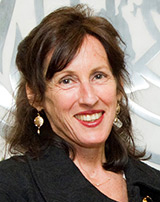Climate-altering technologies in the Arctic: time for a global discussion on governance

The Arctic is critical to the stability of the global climate system. It is thus no surprise that scientists are deeply concerned that the Arctic has warmed more than twice as fast than the rest of the Earth over the past 40 years. The United Nations Environment Programme has recently warned that we may have already reached a “climate tipping point.” This threshold, once breached, can lead to permanent changes in the Arctic and, over time, the entire planet.
To counter these risks, scientists are exploring the use of climate-altering technologies that could lower temperatures by reflecting the sun’s radiation back into space, or those that seek to protect and increase Arctic ice.
Ideas include spreading reflective silica spheres on the ice; brightening clouds above the ocean; or spraying reflective aerosols in the stratosphere. But as the planet – and particularly the Arctic – continues to warm, policymakers face difficult choices that will have consequences not only for this region, but for the world, and not just for this generation, but for many generations to come.
Decisions on whether to test or deploy these technologies must be taken in the context of the serious risks we already face, given that global emissions continue to rise. What criteria and considerations should policymakers have in mind when they think about these emerging, climate-altering technologies? All entail risks – known and unknown – and costs as well as potential benefits.
How can those most likely to be affected, including indigenous populations, as well as communities around the world whose populations are particularly vulnerable to climate change, be part of this global discussion? And how can those who will have to deal with the consequences of any use – or non-use — of these technologies for years to come, learn more and engage in this crucial policy debate?
One prominent scientist, Sir David King, the UK’s Special Representative for Climate Change from 2013-2017, has announced plans to set up ‘The Centre for Climate Repair’ in Cambridge University, to study these and other ideas in more depth.
“We want to be sure that the experiments that we conduct to check these technologies are performed under the strictest conditions,” he said. “We want to be sure that any technology put into practice is unlikely to have unintended consequences.”
At the same time, he warns we must weigh the risks against the costs of inaction. “It has reached that point where more than 50 per cent of the Arctic sea is now exposed to the summer sun, and the net result is that that region of the planet is now heating up at more than two times the rate of the rest of the planet,” said Sir David.
“The big danger with that, of course, is the ice on Greenland is going to enter the ocean and push up the sea level. If all of it melts, the sea levels will rise by 7 meters,” he added. “One or two meters sea level rise would mean that virtually every ocean-based city, cities on coastlines round the world, which is roughly 80% of the world’s cities, would no longer be livable.”
Similar concerns are prompting a growing number of scientists to conclude that the risk of testing or even deployment of some of these emerging technologies may be outweighed by the risks of a rapidly warming Arctic.
But who gets to decide these critical questions, and how? In which governance arena should these discussions take place? The Intergovernmental Panel on Climate Change (IPCC) last month released a special report on The Ocean and Cryosphere in a Changing Climate, providing further evidence of the effects of rapid warming on the polar regions. As policymakers consider the risks and potential benefits of climate-altering technologies, what role should the scientific community have in supporting decision-making?
Who should be consulted and included in these critical conversations, given that the consequences would affect not only those living in the Arctic, but over time, the world as a whole? These are very difficult questions and for the moment there are no clear answers.
Existing governance for this suite of technologies is incomplete and not well coordinated. Important governance gaps need to be addressed at the global as well as regional and national levels.
One thing does seem clear, however: if the world is to go ahead with testing or potentially deploying some of these approaches, a lot more consultation, outreach and learning is needed, including with local communities and young people, who are increasingly vocal about the need to include their voices in decisions with momentous consequences for their future.
Given how quickly the Arctic is warming, these discussions are increasingly timely and important.
Expanding the Conversation
To this end, C2G is hosting two breakout sessions at the 2019 Arctic Circle Assembly in Reykjavík, Iceland on 10 October 2019.
Governing Emerging Climate Technologies in the Arctic will explore which emerging climate technologies researchers are considering with respect to the Arctic, what their effective governance might include, and their implications for the region and, indeed, the world at large. Speakers include the former chief scientific adviser to the UK government, Sir David King; ice climatologist at the Geological Survey of Denmark and Greenland, Jason Box; Regional Director for the Native Movement in Alaska, Shawna Larson; and Icelandic Youth Environmentalist Association chair, Pétur Halldórsson.
Saving the Arctic: Ethics, Values and the Next Generation will look at the role ethics and values play in shaping governance of these powerful technologies. In seeking to ‘save’ the Arctic with climate-altering technologies, are we opening a Pandora’s box that could lead to other risks for the rest of the world and for generations to come? Speakers include Canada’s Prime Minister Youth Council member Ashley Komangaapik Rose Cummings; Caritas Denmark Secretary-General Maria Krabbe Hammershøy; University of Lapland Arctic Centre researcher Ilona Mettiainen; and Sir David King, the former chief scientific adviser to the UK government.
C2G sees this as the beginning of conversation, coming at a crucial time. We have created a number of materials that can contribute to society-wide learning. Now is the moment when an informed public can help shape governance decisions that will have global consequences for generations to come. We invite you to look through our materials, form your own views, educate others, and get involved. Because what happens in the Arctic will eventually affect us all.
